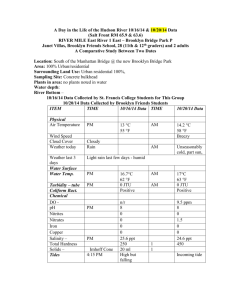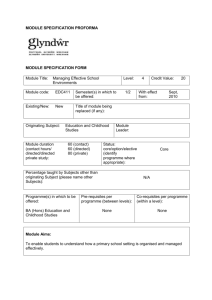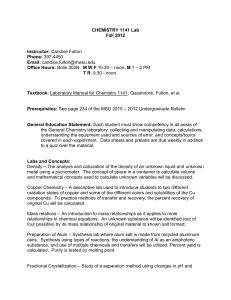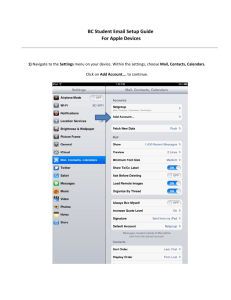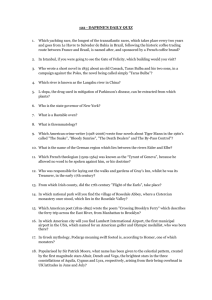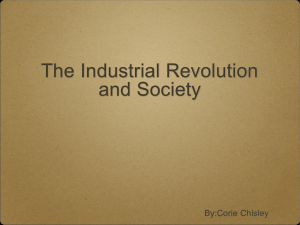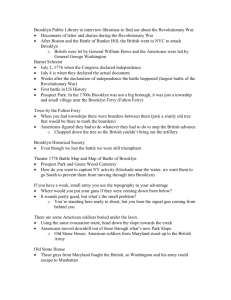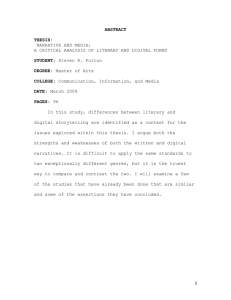THE BROOKLYN BRIDGE HOTEL: 1 ANN
advertisement
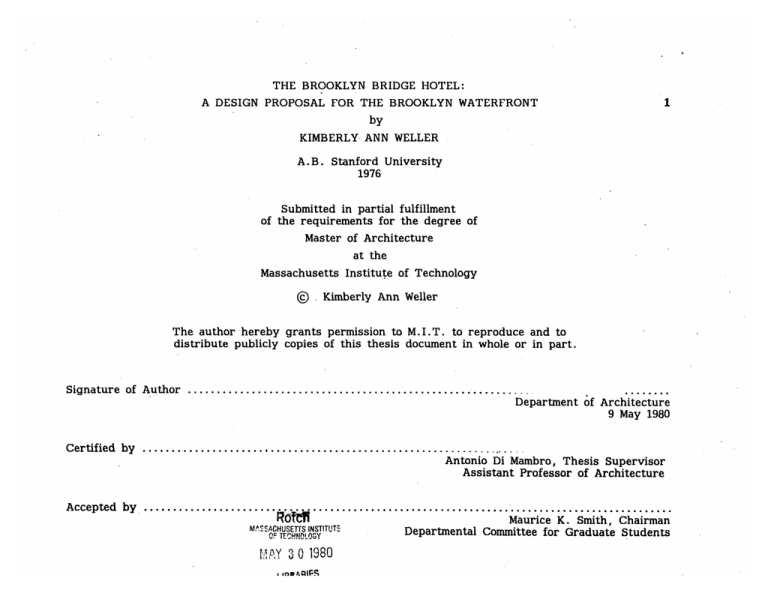
THE BROOKLYN BRIDGE HOTEL: A DESIGN PROPOSAL FOR THE BROOKLYN WATERFRONT 1 by KIMBERLY- ANN WELLER A.B. Stanford University 1976 Submitted in partial fulfillment of the requirements for the degree of Master of Architecture at the Massachusetts Institute of Technology @ . Kimberly Ann Weller The author hereby grants permission to M.I.T. to reproduce and to distribute publicly copies of this thesis document in whole or in part. Signature of Author ..................................................... Certified by ..................... ....... Department of Architecture 9 May 1980 .................................... Antonio Di Mambro, Thesis Supervisor Assistant Professor of Architecture Accepted by......... ......................................... W ........... 7TgACHUSEyTS MUMTIITE MA\Y 3 0 1980 LBARIES Maurice K. Smith, Chairman Departmental Committee for Graduate Students MITLibraries Document Services 77 Massachusetts Avenue Cambridge, MA 02139 Ph: 617.253.2800 Email: docs@mit.edu http://Iibraries.mit.edu/docs DISCLAIMER OF QUALITY Due to the condition of the original material, there are unavoidable flaws in this reproduction. We have made every effort possible to provide you with the best copy available. If you are dissatisfied with this product and find it unusable, please contact Document Services as soon as possible. Thank you. The images contained in this document are of the best quality available. Table of Contents 3 Page Abstract..................................... 5 Acknowledgements...........................7 Introduction................................. Site Analysis................................1 Program.....................................3 9 3 7 Design Proposal.............................41 3 Appendix....................................7 5 Bibliography................................ 87 Conclusion..................................7 Abstract 5 THE BROOKLYN BRIDGE HOTEL: A DESIGN PROPOSAL FOR THE BROOKLYN WATERFRONT by KIMBERLY ANN WELLER Submitted to the Department of Architecture on May 9, 1980, in partial fulfillment of the requirements for the degree of Master of Architecture. This thesis makes a proposal for the development of a site at the foot of the Brooklyn Bridge pier in Brooklyn, New York based upon the following objectives: recreational, and economic assets of the East Riverfront. 1. Exploitation of the environmental, 2. Revitalization of the district in which the site is located. 3. Enhancement of the unique historic character of the district. The study proceeds from a site analysis to the generation of a mixed-use program for the site. these, a physical design proposal is made. From Acknowledgments 7 I would like to express my deepest thanks to: My parents, for their continuing and unending support, encouragement, endeavor and throughout my education. and patience throughout this Roy and James, who infected me with their love of New York. Antonio Di Mambro, advisor. Edward Allen, reader. Henry Millon, reader. Darleen, Laurie, Wendy and Linda for their generous time and effort; and my fellow thesis students: Jon, Suzanne, Charles, Walter, and Zaurie, for their crits, moral support, and companionship. Introduction 9 9 The Fulton Ferry district is at a critical point in its historical evolution. Situated on the East Riverfront between the Manhattan Bridge and Brooklyn Heights, the area was once a thriving center of shipping and industry, as well as the location of the Brooklyn terminal of the Fulton Ferry, which connected that city with Manhattan. With the building of the Brooklyn Bridge in 1883, however, traffic began to by-pass the area, and the district began a decline that has continued to the present day. Recent development indicates that this trend is reversing: many of the lofts and warehouses in the district are being converted to residential use; new restaurants and a barge music hall have opened; and a private concern is seeking to reinstitute the ferry as a commuter service. In the past year, the City has assembled the waterfront property in the district, for the first time making available to the public the land that was once the exclusive domain of the shipping industry. How this land is developed is crucial. If properly planned, the municipal property could serve as a catalyst to further renewal of the dis- trict, enhance the -unique historic character of the area, and provide inviting access to one of the City's greate't assets--its waterfront. This thesis provides a physical image and set of recommendations for the development of a portion of the municipal holdings--the land at the terminus of Fulton Street. The study proceeds from a thorough site analysis to the generation of a mixed-use program for the site, based on current City and State proposals. Programmed uses \Je Regional Context 10 View of site and Lower Manhattan 11 include: a plaza for Fulton Street, a waterfront park, a 350-room hotel, a small museum devoted to the Brooklyn Bridge and Fulton Ferry, sional ferry. - profes- the revived The physical design focuses on the relaand a terminal for offices, ...... .. tionship of the public areas of the hotel, museum, and terminal to Fulton Street and the Waterfront Park. \K ....... .. . . ......... ... . . Study Area/Site $1-Site z.< Ih- The Fulton Ferry District Vine St. 12 the design 5. Development of the site as a catalyst for renewal of the district. recreationEast River- 6. viewing the Attraction of a broad range of users to the waterfront. Provision of a distinct and memorable image for the site, while being sensitive to the sur- Creation of major new open spaces at the water edge and on Fulton Street that are 8. rounding built context. Incorporation of a sense of the history of the site and district in the new development. integrated with each other and with existing 9. Restoration and preservation of the historic 10. character of Fulton Street. Improvement of pedestrian access to the site. The following goals have guided study for the site: 1. Exploitation of the environmental, al, and economic potential of the front. 2. Increasing the opportunities for 7. Manhattan skyline. 3. 4. open spaces. Re-establishment of the site as the activity center for the Fulton Ferry district. Site Analysis History The history of the Fulton Ferry district is one of commerce and transportation. The Dutch settled the area when a ferry service between "Breukelen" and Manhattan was initiated in 1646. The early ferries were rowboats, flat scows with sprit sails, and two-masted sailboats, all dependent on the winds and tide. Gradually, a small but bustling community grew around the ferry landing, which was the terminus of the Old Ferry Road. Officially laid out in 1704, this road was Brooklyn's principal artery, and ran from the ferry landing to Jamaica and eastern Long Island. It was along this road that farmers brought their produce to market and livestock to slaughter. The Fulton Ferry district continued its growth in the 19th century. In 1814, a steampropelled ferry was introduced on the Fulton Ferry Line to New York. The new ferries carried several hundred passengers, as well as horses The ferries were capable of 40 and wagons. In honor of eight-minute crossings per day. Robert Fulton, developer of the steam engines 13 which powered the boats, Old Ferry Street was renamed Fulton Street. By the mid-1820's a number of commercial institutions--banks, fire insurance companies, and law firms--had settled along Front Street. Small maritime industries and warehouses located along Water Street. Shops with residences above lined Fulton Street by the late 1830's. 14 The problem of transit to the ferry from the newly developed inland sections of Brooklyn and from Long Island had become acute by the mid19th century. The Brooklyn City Railroad Company replaced the old stagecoaches with twelve horse-car lines which converged at the Fulton Ferry. By 1867, these lines carried 22 million passengers a year, and by the time the construc- Stages of construction (Harper's New Monthly Magazine, May 1883; Bettmann Archive) tion of the Brooklyn Bridge began in 1870, the ferries and horse-car lines carried about 50 million passengers annually. On May 24, 1883, the Brooklyn Bridge formally opened amid festivities on both sides of the East River. A road and walkway joined the cities of New York and Brooklyn for the first time, and by September the bridge included a transit line as well. With the opening of the Brooklyn Bridge, however, traffic began to by-pass the Fulton Ferry district. Though the ferry continued for 40 years after the opening of the bridge, the district fell in importance as a viable commercial area. The decline is reversing with the recent renovation and re-use of existing structures in the district. 15 Architectural History The buildings of the Fulton Ferry district have changed little since the 19th century, and are excellent examples of the industrial waterfront architecture of that time. The Empire Stores, a series of seven brick warehouses, form an almost continuous wall along Water Street between Main and Dock Streets. Completed in 1870, the stores were originally used for storage of raw materials such as coffee beans, sugar and molasses. animal hides, The simple grains, raw facades are punctuated by regularly-placed arched windows Despite a height fitted with cast-iron shutters. of only four to five stories, the buildings achieve an austere monumentality. The Empire Stores were among the many warehouses constructed along the Brooklyn waterfront during the post-Civil War economic boom. the waterfront was so completely lined with privately-owned warehouses and docks that By 1870, The Empire Stores and Gair Building story loft buildings northeast of Main Street. Robert Gair, an early entrepreneur in the corrugated box industry, built these structures. The north side of Fulton Street is lined with a row of four-story brick buildings constructed in Brooklyn earned the nickname the "walled city". In contrast to the horizontality and planarity the 1830's. above the Stores is the strongly expressed reinforced concrete framework of the 15- to 17- 1850's, of the Empire the The buildings originally had lodgings first floor shops, but by the late use of these buildings had become strictly commercial. Designed in the Greek Revi- 16 The warehouse was used primarily for the storage Rf ~ ~ ~ '1~ *a household furnishings fl monumental entrance arch. val style, the buildings have simple and restrained Wooden canopies once ex- tended eighteen feet over the sidewalk. silverware. De- signed by Frank Freeman in the rugged Romane sque Revival style, the building is dominated by Rowhouses along Fulton Street architectural detailing. and Unlike the Empire Stores, the individual units that make up the continuous street wall are easily perceived. The buildings step to follow the slope of Fulton Street. The Eagle Warehouse and Storage Company, located on the south side of Fulton Street between Elizabeth and Hicks Streets, was built in 1893-94. The Eagle Warehouse The predominance 17 of the wall surface with its small, vertical openings, and the window grilles on the lower windows, the machiolation-like arches supporting the heavy cornice make the warehouses fortress. Gothic arches, rise to a height of 276 feet above mean water level. resemble a The site under investigation is the traditional location of the Fulton Ferry terminal. A woodframe ferry house and tavern was built at the foot of Fulton Street in 1655, and later replaced with a stone building in 1700. A larger ferry house and tavern was built in 1865. This building combined stick-style Eastlakian elements with a French Second Empire roof over a tower wing, which extended to the center of Fulton Street. The building was demolished in 1926, two years after the ferry service had been discontinued. The existing Marine Fireboat Station, a two-story frame building with a hipped roof and tower, was built on the site in 1926. The Brooklyn Bridge, designed by John Roebling and constructed by his son Washington, dominates the district. The gossamer web of supporting and bracing cables stretches between massive granite piers. The two towers, with their The Ferry House,, 1716 18 The Ferry Terminal circa 1865 19 Natural Conditions The shoreline in the vicinity of the site is all landfill and has been altered repeatedly over the years. At the time of the Revolution, accord- ing to the Ratzer Map of 1766-67, Front Street was the last street above the waterline. The site of the Empire Stores was filled after a line of bulkheads was established in 1885. Early engravings illustrate the varying shape of the site shoreline, and a map as late as 1962 shows a configuration different from that of today. Fulton Street slopes down to the site, affording improved views of the Manhattan skyline. The site is relatively flat, and about 10 feet above mean water level. The water level varies about four feet throughout the year. The site is located in a region of temperate Temperatures average 52*F, with averclimate. age highs of 73 0 F in July and 30*F in January. Precipitation is well-distributed throughout the year, averaging 43 inches per year. fall occurs in February. Most snow- Periods of excessive humidity coincide with the hottest months, June, July, and August. Prevailing winds are from the Natural Conditions northwest throughout the year, although summer winds are more variable, with frequent breezes from the south. High velocity winds are almost invariably from the northwest. 20 Land Use The Fulton Ferry district, which originally developed as an industrial waterfront area, is North of Fulton Street, undergoing change. much of the land remains in industrial use. The Empire Stores, recently purchased by the State Commission of Parks and Recreation for the City of New York, lie vacant. Uses proposed for the 340,000 square feet contained in the buildings include retail or industrial space, housing, a state maritime museum, a hotel, or a sports club. During the past few years, artists and architects have renovated many of the existing residential buildings on Fulton and Front Streets. With the skyrocketing cost of housing in Manhattan, however, larger scale development is taking place in the district. The Eagle Warehouse and the Watchtower building east of Columbia Heights are being converted to apartments. As housing pressures in Manhattan increase, gentrification in the Fulton Ferry area is likely to accelerate, just as it did in adjacent Brooklyn Heights. Concentrated on the north side of Fulton Street, commercial uses in the district are limited for the most part to bars, restaurants and convenience stores that serve the dock workers, truck men, and local residents. A large restaurant and a barge music hall that draw a regional clientele have opened recently at the foot of Fulton Street. Land Use j.:Industrial Residential Commercial Institutional Vacant 21 Institutional uses are scattered throughout the district, and include the Department of Ports and Terminals shipping facility, the Fulton Ferry 'R Museum in the Marine Fireboat Station, and several city-owned maintenance and storage buildings. .11 There is little vacant though some buildings are land in the unoccupied. area, Three small empty lots are located on Fulton Street. The site is currently occupied by part of the Department of Ports and Terminals freight pier to the south, the Marine Fireboat Station, the barge restaurant and music hall, a parking lot, and a small park. Open Space The city and state have recently completed the assembling of the waterfront property on and adjacent to the site. A two-acre boardwalk park east of the site has been opened by the State Commission of Parks and Recreation for the City of New York. Open Space 1. Cadman Plaza 2. Boardwalk Park 3. Brooklyn Bridge Promenade 4. River Cafe and Marine Fireboat Station Park 5. Edward Robinson Squibb Park and Brooklyn, Promenade 22 Other open space within the area includes the raised pedestrian walks on the Brooklyn Bridge; the Brooklyn Promenade, located above the Brooklyn-Queens Expressway; Cadman Plaza, a passive recreation park; and Edward Robinson Squibb Park, a playground at the terminus of the Brooklyn Promenade. A small park was recently built by the Department of Ports and Terminals on the site. Circulation The site is served by three subway lines and several bus lines. The nearest subway station is the High Street-Brooklyn Bridge stop, at a distance of 3/8 mile. The State Commission of Parks and Recreation for the City of New York has recommended the consideration of a small subway station on the Manhattan Bridge to improve the accessibility of the waterfront. Two buslines stop on Fulton Street, adjacent to the site. Mass Transit 23 A private concern is seeking to reinstitute a commuter ferry service between the historic ferry landing on the site, the South Street Seaport, and possibly Wall Street. Traffic in the vicinity of the site is concentrated on Fulton Street near McKenney Street, where the Manhattan Bridge, Brooklyn Bridge, and Brooklyn-Queens Expressway ramps converge. Most of the traffice that continues down Fulton Street turns onto Furman Street to reach Atlantic Avenue and downtown Brooklyn. Trucking traffic is heavier to the east of Fulton Street, where the industrial lofts are located, and on Furman Street, near the Department of Ports and Terminals pier. Three pedestrian ways terminate in the vicinity of the site: the Brooklyn Promenade, the Brooklyn Bridge walk, and the new Boardwalk Park. The Brooklyn Promenade and Bridge walkway are well-used by strollers, joggers, and cyclists while the Boardwalk Park is kept locked Traffic Flow Regional Pedestrian Circulation 24 much of the time. The connection of these three promenades with each other and with the water- front could be improved. Most pedestrian traffic reaches the site from Fulton Street or Columbia Heights and Everit Street. The heavy traffic on Fulton Street near the Brooklyn-Queens Expressway makes pedestrian access difficult. Traffic lanes are not defined on the broad portion of Fulton Street near the site, and cars roam freely, endangering pedestrians. There is no signalization. k 1.i On Brooklyn Bridge (Photograph by Wayne Andrews) 25 Legal Considerations Current zoning for the site, and for that part of Fulton Ferry district to the east of Fulton Street, is Medium Manufacturing - Medium Performance with an allowable F . A. R. of 2.0 and required parking. Land to the south of Fulton Street is zoned for medium density residential uses. Pierhead and bulkhead lines have been established for the site by the U.S. Army Corps of Pierhead and Bulkhead Lines The eastern portion of the site is Engineers. owned by the City, while that to the south is owned by the Department of Ports and Terminals. The Marine Fireboat Station located on the site is an individual historic landmark. 26 Urban Form: Imageability The site is located in a district that is clearly identifiable from within and from afar. The Fulton Ferry district has distince edges--the East River, the Brooklyn-Queens Expressway, and the rising topography of Brooklyn Heights. The fourth side is less clearly delineated; the Manhattan Bridge forms a permeable boundary. Fulton Street, with the site at its terminus, is located at one edge of the district and acts as a seam between the grids of Brooklyn Heights and Clinton Hill. Land uses change to either side of Fulton Street; industry is located to the east, and residences to the south. The paths which transverse the district help to make it easily identifiable. The Brooklyn and Manhattan Bridges and the Brooklyn-Queens Expressway pass overhead, while Fulton Street and Furman Street are major routes at grade. Fulton Street is an historic node for the district. It was at this point that goods were moved from land transportation to ship, passengers boarded the Fulton Ferry, and a market thrived. Though these activities have long since ceased, District-Edge-Path-Node-Landmarks - ---- ;;;X 1. 2. 3. 4. 5. 6. 7. Edges Permeable edges Node Brooklyn-Queens Expressway Eagle Warehouse Marine Fireboat Station Brooklyn Bridge Empire Stores Gair Building Manhattan Bridge 27 the street continues to draw people because of the splendid view of Manhattan and the river that it offers. the industrial nature of the buildings, the hum of the traffic on the bridges, and the dusty smell of spices near the Empire Stores. The district has several regional and local landmarks: the East River, the Brooklyn and Manhattan Bridge towers, the towers on the Gair and Watchtower buildings, the Empire Stores, the Eagle Warehouse and the Marine Fireboat Station. A number of other factors contribute to the unique character of the area: The Fulton Street "Seam" the high density, Marine Fireboat Station 28 Urban Form: Density The Fulton Ferry district is densely built; none of the buildings are set back from the narrow streets, and there are few vacant parcels. Only near the site, where Fulton Street opens onto the river, is the sense of near-claustrophobia relieved. Heights range from two-story warehouses to 17-story industrial lofts; most buildings have four to five stories. The tallest buildings are concentrated on Main Street near the Manhattan Bridge; the lower Empire Stores form a continuous wall along the waterfront; and four-story rowhouses line Fulton Street near the site. Sizes range from industrial buildings that occupy entire city blocks to 20- by 60-foot rowhouses. Rowhouses Warehouses Industrial Lofts Solid-Void 29 The Fulton Ferry district 30 Urban Form: Vocabulary The Fulton Ferry district has a rich vocabulary of form that reinforces its distinctive image and that might be used to inform the design of a new building on the site. The formal characteristics of the district include: __ Verticality Horizontality . Towers and Lofts 31 Manhattan Skyline Makes a Lively Silhouette Silhouette Buildings Parallel to River Piers Extend into River Buildings Perpendicular to River 32 ..aPiers Bridges I""ll1 Towers Jut Out into River 33 Continuous Vertical Surface M Iwith Small Openings Bearing Wall Industrial Loft Buildings Exposed Structural Skeleton with Infill Panels Frame Grand First Floor, Repetitive Middle Floors, Distinctive Top Floor Classical Facade Organization 34 Arches What Remains of Fulton Street's Historic Canopies Canopies Brooklyn City Railroad Company Building The Brooklyn Bridge Materials: Granite Cast Iron 35 Brick Concrete Steel Wooden Piles Support Piers -i--------------- Wood Program 37 The program has been developed from current proposals by city and state agencies for the district, as well as from the objectives stated The various components of the program are described below, with more detailed listings in the appendix. earlier. Uses have been selected which would work symbiotically to re-establish the site and Fulton Street as a major waterfront activity center. Though an attempt was made to be realistic about the types of uses that might occupy the site, it was not possible to confirm their economic and political viability. The value of the program lies not in the specific uses proposed, however, but in the generic physical solution for the site that can be derived from them. The program was used as a vehicle for the design exploration, lending an air of reality to Fulton Street The revitalization of Fulton Street will provide an more inviting approach to the waterfront. Vacant parcels along the once continuous streetwall will be rebuilt as shops with housing or office above. A mall will further enhance the pedestrian environment. the study and making clear the need to address a variety of issues, such as orientation, access, and "image". On the other hand, the design ex- Waterfront Park Development of a park at the water edge will comply with the city's policy of maintaining the waterfront accessible to the public. Coordination of the park with the existing Boardwalk Park, Brooklyn Bridge Promenade, and new waterfront- ploration helped to refine the program. related Massing studies showed whether the built volume called for in the program was too great or too little to achieve the desired formal objectives. public and private uses will make it a regional attraction. 38 Brooklyn Bridge Hotel (350 rooms) The City of New York has requested a proposal for a 300-500 room hotel with banquet facilities to be located either on the selected site or on one of two other city properties in the district. Brooklyn presently lacks a large, luxury hotel. A hotel on the selected site will offer a waterfront location in an historic district with a splendid view of Manhattan. A hotel, with its restaurant, shops, and meeting facilities, will contribute to a lively waterfront environment both day and night. Museum (25,000 square feet) The Department of Parks and Recreation has proposed that the New York State Maritime Museum be located in the district. However, a maritime museum already exists across the East River in the South Street Seaport area. The position of this museum undoubtedly will be strengthened with the development of the planned Rouse Company South Street Seaport marketplace. A smaller facility, which would complement, The Brooklyn Bridge - Original Drawing 39 rather than compete with, the museum on the Manhattan shore, is more appropriate for the Fulton Ferry district. The museum, like the hotel, will draw local and regional visitors to the waterfront. The museum will be devoted to the history of the Brooklyn Bridge, the Fulton Ferry, and Brooklyn waterfront industry of the 19th century. Professional Offices (15,000 square feet) Subdividable office space can be used either to accommodate hotel or museum administrative requirements, or for lease. Offices will support the restaurants and conference facilities in the hotel. Fulton Ferry Terminal (2,000 square feet) A private entrepreneur is attempting to revive the Fulton Ferry service between the South Street Seaport area, Wall Street, and the Fulton Ferry district. Placing the Brooklyn terminal on the selected site, its historic location, will improve the connection between Manhattan and Brooklyn for commuters, hotel guests, and visitors to the two waterfront museums. Parking Parking will be provided for visitors to the park and museum, hotel guests, ferry passengers, and employees. 0D 0 0l 42 43 -w 44 ~49 CA jjWON Fulton St. 1 Infill Buildings 2 Canopies 3 Vendors / / Waterfront Park -131f 0102040 1. Brooklyn Bridge Pier 2. Elevators 3. River Cafe 4. Museum Exhibits 5. Fulton Ferry 6. Historic Ships 7. Marine Fireboat Station 8. Music Barge 241:212:- 112 io: 10 ' 10 4 7 7 -8- 7 1 8 7 1 2 8 - B 3. 0:1rcade-. Hotel - East Wing Ground Floor 0 10 20 40 1. museum/of fice Inbby 2. Museum Exhibit 3. Arcade 4. Fulton Ferry Terminal office 5. Fultan Ferry Terminal Waiting Area 6. Restrocan 7. Shop 8. Vendors 9. Cafe 10. Shop Storage 11. Kitchen 12. Receiving -- 50 5 Hotel- East Wing Floor 2 TU~L-i 010 20 40 1. 2. 3. 4. Upper Lobby Information Coat Room Restroom 5. Gallery 6. Bridge 7. Open to below 8. Conference 9. Storage 51 - ii |ITI-M -r-r- 4 " rrrr-r-r-r-f .... "-I _ -16 4 Hotel -East Wing Floor 3 010 20 40 1. Office 2. Roof Terrace 3. Open to below 4. Hotel Room 5. Maid's Room 6. Transfer Lobby 7. Conference 4 4 rr r r -r-r-TT-r T Trr - r- IT ..... 7 7 52 Hotel -East Wing Section A-A frI_.J 0 1020 40 53 1~ Hotel - East Wing Section B-B 0 10 20 40 54 -4 Hotel - East Wing East River Elevation m 1A1 55 Hotel - South Wing / Floor 1 0 10 20 1. 2. 3. 4. 5. 40 - Arcade Hotel Lobby 6. 7. 8. 9. 10. 11. 12. 13. 14. - Bellman _____ Coat Room Front Office Restroom Office Lobby Shop To Parking Museum Exhibit Reception Court Vendors Kitchen and Support-Facilities Receiving -- - - - - - ------- - 8 2 - 12 r 15. Bar 8 16. Restaurant 8 - 18. Coat Room - 83 17 18- A -A S 16 6 131 44 9 6 B 56 111 16. A. Hotel - South Wing Floor 2 0ri2Li 0 10 20 40 Office Lobby Open to below Office Conference Storage Bridge 7. 8. 9. 10. 11. Banquet/Ballroom Lobby Restroom Coat Room Banquet/Ballroom Banquet/Ballroom Pantry 0 C 12 0 S4 0 CQ 0 0 58 E:7P-- -Fr1rT FFFFF- RFF1, lihrF F4 11 4Mob I 0 I Ih PWR.I L Hotel - South Wing Section A-A FL~L.J 0 10 20 40 II I-I~ I U II _I 1 11 1 59 1 Ii m U 1i t-77tt' M a~ I II AV HHI HH mwht -Y T HVH1]H~ "Y j I I - ~ It r.-L._J 10'20' 40' I --"IIdIl7iL !IL-III 1 L-r-d I Hotel- South Wing Section B-B m1 I I IFFU I "F1 IJ- 1 I IIIFI 11 iI. 1-InI:-~* I~iH n .1 I II 1 - KM_ 61 The design proposal seeks to provide an appropriate physical image for the site. The study includes schematic proposals for Fulton Street, the Waterfront Park, and the. hotel, which includes the museum, offices, and ferry terminal. The following assumptions underlie the proposal: 1. Development of the project is economically and politically feasible. 2. Private investment will continue to revitalize the Fulton Ferry district. 3. The city will upgrade roads, sidewalks, and services in support of private investment in the area. 4. Land use in the area will change from industrial to commercial and residential. (The Empire Stores will be developed as housing with shops below.) 5. The proposed Fulton Ferry will be instituted. Fulton Street The design proposal re-establises Fulton Street as the gateway to the waterfront and Brooklyn. The broad street is given closure at its terminus by the hotel, which still allows a view through to the river and Manhattan. The end of the street is defined by a tower on the new building in much the same way as the ferry terminal of the late 1800's marked the entry to the waterfront. In order to improve the ease and safety of pedestrian movement to the waterfront, traffic on Fulton Street is confined to three lanes, and the pedestrian right-of-way to either side is widened. Fulton Street remains two-way with one lane for 62 Signalization and crossparking and drop-off. walks defined by a change in paving further increase safety. The sidewalk on the south side of the street, widened to 20 feet and lined with trees, connects directly to the Waterfront Park. A funnel-shaped plaza on the north side serves existing and proVending stalls at posed shops and restaurants. the street edge make a two-sided shopping mall. Trees and the restored historic canopies provide shade for the southern exposure. New buildings with ground floor shops and office or housing above fill the vacant parcels To maintain the , historic along Fulton Street. configuration of the street wall, the buildings are four to six stories high, are built to the existing property frontage lines, and have their major The Waterfront Park The focus for the design proposal is a major open space, the Waterfront Park. The park is a broad promenade encircling a "bay" created by removing portions of existing piers. and surrounding park approximate the configuration of the waterfront in that location at the time of the construction of the Brooklyn Bridge, thus bringing a sense of historic continuity to the The shape of the bay is also dedevelopment. rived from Fulton Street; the north part of the :1 entrances off Fulton Street. Doughty Street has been widened The bay to two lanes near the site to make a convenient traffic turn-around from Fulton and Furman Streets. A bus stop is located at the foot of Fulton Street adjacent to the ferry terminal. Drawing by Imre Halasz mob 63 Brooklyn Bridge, 188; (Frank Leslie's IllustratedNewspaper, May 26, 1883) river. By enclosing a small piece of water, the Waterfront Park domesticates the East River, and increases its accessibility to the pedestrian. The Waterfront Park links new and existing open space to create a regional park system. At the foot of Fulton Street, the two wings of the hotel are connected by only a light bridge to allow views and access to the waterfront. A row of bay takes on the geometry of one side of Fulton Street, while the southern part follows that of the other. The Waterfront Park is defined by the wings of the waterfront hotel and the Brooklyn Bridge. The two towers of the building and that of the bridge mark the corners of the bay, making it identifiable from Brooklyn and from across the 64 Museum visitors will enjoy the displays of maritime artifacts on the raised platforms lining the park, the historic ships docked of Fulton Street. and the Marine Fireboat Station--an landmark in itself--which will contain in the bay, historic A grand stair that steps down to the water level and seating under a grove of trees are available for those who want to relax museum exhibits. The restaurant and music barges will continue to serve their clientele in approximately their original locations. and take in the view. trees leads from the Waterfront Park and up the Fulton Street Plaza to the Brooklyn Promenade, and Cadman Plaza. Two glassy elevators climb the Brooklyn Bridge tower to the promenade above the traffic deck and to an observatory at the top. The east wing of the new building is pulled back from the pier to allow continuation of the Waterfront Park under the bridge to the Boardwalk Park. The Waterfront Park offers a variety of Joggers, cyclists, and strollers can activities. take advantage of the park's connection to the Brooklyn Promenade and Brooklyn Bridge walkway. The Fulton Ferry will deliver passengers to a waiting shelter and interior terminal at the foot 65 The park is constructed over fill and on piers. The eastern and northern parts of the park rest on fill and are paved with granite, the The Hotel: same material of which the Brooklyn Bridge piers The Brooklyn Bridge pier defines the third side. At the foot of Fulton Street, the wings are connected only by a light bridge to allow views of are made. The southern part of the park is on a concrete deck supported by pilings so that the flow of the East River to the ocean will not be impeded. The docks for the historic ships are wood decks on wood pilings. Massing The hotel is divided into two long wings which form the back and one side of the new bay. and access to the waterfront. Like the Water- front Park, each wing follows the geometry of the adjacent side of Fultion Street. The east wing, lying parallel to the river, continues Brooklyn's historic "wall," of which only the Empire Stores remain. The south wing, which is perpendicular to the river, is like one of the old pier buildings. The horizontality of the river, and the height of the buildings on Fulton Street are reflected in the long, low part of the wings. The verticality of the Brooklyn Bridge and the industrial lofts is expressed in the towers of the hotel. The towers not only make the site easily identifiable from a distance, but take ad- vantage of the view across the river. With the Brooklyn Bridge tower, those of the hotel building help to define the bay. The tower of the east wing terminates Fulton Street and marks the entry 66 L LI I/ I / I X' ~il r C'- Horizontality to the Waterfront Park. Silhouette The towers and monitors on the low portions of the hotel building offer a J lively silhouette to viewers on the Manhattan bank. // The building is massed so as not to overpowDefining the Waterfront Park Terminating Fulton Street er, nor be overpowered by the Brooklyn Bridge: the hotel towers are located a good distance from that of the bridge, are lower than the traffic deck, and are narrower than the pier. The lower portion of the east wing maintains a constant height as it extends under the traffic deck. 0E 4-2 J I Organizational Framework , The hotel building is organized along a two- Ic~. Geometry Li, story interior arcade that parallels the waterfront promenade. Major hotel and museum functions are strung along the arcade; entries to all public buildings open off the interior promenade. A twostory museum exhibit (perhaps a ship) greets the visitor to the east wing. Small museum diplays in 67 The Waterfront Arcade 68 glass cases are placed along the arcade; banners showing 19th century waterfront life hang from the high ceilings. Coffee shop and bar tables and seating for the ferry terminal extend into the passageway. Hotel shops and vendors line the arcade. The arcade is enclosed as much of it does not receive direct sun and is exposed to the northwest wind. The enclosure is mostly glass, however, in order to take advantage of the views of Manhattan, the bay, and the bridge. Concrete piers march along the outer edge of the arcade. The ceiling varies along the interior promenade: near the main entries it is low; in some places it is skylit; in others it is sloped. Bridges cross the arcade at the second level, recalling the bridges of the district. Distribution of Uses The building is zoned from public to private both horizontally and vertically. The public functions of the building line the waterfront and the terminus of Fulton Street, while service functions and parking are located along Water Street and south of Doughty Street. The most public uses--hotel lobby, certain museum exhibits, ferry terminal, restaurant, bar, and shops--are concentrated on the ground floor off the interior arcade and in association with the waterfront promenade. Public uses with restricted access--the banquet hall, meeting rooms, and museum--are located on the second floor. The third floor houses the more private professional offices and guest rooms, and serves as a transfer level for access to the two towers. More guest rooms 69 and some suites occupy the fourth floor. The two towers hold guest rooms and are topped by penthouses. The east wing has a rooftop bar, and the south, a luxury suite. (Services and mechan- ical are contained in a basement under the east wing and that part of the south wing on landfill.) Uses are oriented to the view. The arcade, restaurant, and banquet hall offer panoramic Circulation Hotel guests park in the garage or arrive by taxi at the main entry to the south wing, check in at the lobby, and take an elevator to their floors, or to a transfer floor if their rooms are in a tower. Service access to the hotel is from an alley off Furman Street. provided for hotel employees. vistas, while the museum gives only glimpses of the view. Single loaded corridors are used so that more guest rooms can face the view. Outdoor space is provided for the building in addition to the Waterfront Park. A large courtyard in the south wing can be, used as an outdoor cafe or for receptions; the restaurant, ballroom, museum, and offices have terraces; a courtyard in the east wing has skylights that serve the museum below; balconies are provided for some of the guest rooms; a tennis court is Service elevators are Hotel Guest Access located on top of the parking garage; and gardens top the towers. Service Access 70 Persons attending conferences or banquets the museum, as well as the shops, is provided off use the stairs along the arcade in the south wing or the elevator near the banquet hall. Water Street. visitors enter the east wing from Fulton Street and ascend the lobby stair or elevator, or view the informal exhibits in the arcade and along the Waterfront Park. Service access to Offices in the east the south and east wings. wing share the museum service elevator. Casual visitors to the Waterfront Park may Museum Conference/Banquet Access Office use the office elevators in enter the arcade at any of several points. Office Access Flr. workers 71 Elevations The organization of the elevation reflects that of the building. The two public floors facing the view are largely transparent and are punctuated by a series of concrete piers. The third floor, the transfer level, is defined by a continous line of balconies or brises-soleil. Above and below this datum, the elevation has relative freedom. Monitors and the two towers rise above, while terraces, glass sheds, signs, and lighting animate the lower floors. 11111 Elevation Organization Building System The hotel structure is a concrete frame with infill panels in the same spirit as the industrial lofts in the area. The 28' x 28' or 28' by 14' bay sizes are determined by the sizes of the guest rooms. Concrete pylons supporting the structure extend through the fill or river to solid bearing. Those in the water are capped by a concrete deck. Infill panels are operable and non-operable glass and aluminum. The walls dividing the guest room balconies are concrete. Pre-cast concrete elements are used where guest rooms join. Conclusion This thesis sets forward aspirations and conceptual proposals for the municipal property at the foot of the Brooklyn Bridge. The study has tried to identify some of the issues with which the City will have to grapple if it chooses to develop the site, and to provide physical solutions for them. The thesis has recommended the construction of a hotel on the site; further study may reveal that this use is politically or economically unfeasible. However, it is important that any uses ultimately selected for the site complement the waterfront, improve its accessibility, and promote the revitalization of the district. Development of 73 the site cannot be conducted in isolation, but must be integrated with the reorganization of the Fulton Ferry District as a whole. 75 Appendix: Program Sq. Ft. Hotel Lobby and lounge Front office Restrooms Coatroom and bellman's checkroom 5,650 350 1,220 560 Shops, barber, valet 7,950 Main dining room Coffee shop Bar and cocktail lounge Rooftop bar Private dining/conference rooms Restrooms 5,500 2,500 2,500 1,200 2,500 550 Banquet/ballroom Banquet/ballroom foyer Banquet/ballroom serving pantry Restrooms 4,500 1,125 1,100 225 Main kitchen Kitchen support facilities Auxiliary kitchen 3,800 4,700 500 350 guests rooms (90% @ 400 square feet; 10% @ 550 square feet) .45,250 General service space 16,500 Storage areas, mechanical, and circulation are not included in this listing 76 Sq. Ft. Museum Lobby Security, coatroom, restrooms Bookstore Gallery space Large rooms, suites of galleries, and alcoves to house the following exhibits: 1. Brooklyn waterfront life Diorama of the waterfront Waterfront industries The Brooklyn Eagle 2. The Brooklyn Bridge Drawings, engravings Paintings, photographs Model 3. Fulton Ferry Gallery Engravings, photographs Models of early ferries Arcade Full-size replica of an early ferry Banners showing historic scenes Models in glass cases Waterfront promenade Large, weather- and vandal-resistant objects (anchors, steamship funnels) to be placed on raised platforms Historic ships, to be docked in bay 2,000 450 900 12,000 77 Sq. Ft. Meeting rooms 2,400 Support facilities 6,900 Fulton Ferry Terminal Boatslip for 25' by 70' ferry Covered outdoor waiting area Indoor waiting area Ticketing and office Restrooms Professional Offices Parking 1,200 500 225 15,000 Appendix: Preliminary Design Studies Left: Below: 79 An early organizational scheme. The two-story arcade at the river edge. 80 Massing Studies Upper left: Competing with the Brooklyn Bridge. Lower left: Enclosing a small bay, and marking Fulton Street with a tower--the selected scheme. Lower right: Bridge. Stepping down from the Brooklyn Omy 0'. 1- - - -.. - ".- W- -- .. . .... ...... ... " ,-ift to 8111IMso W . 4. - - , - 1. - I- - - 81 Development of the selected scheme. Appropriating part of the Department of Ports and Lower left: Terminals land (right) to enclose the bay. Right: Studies for Fulton Street. 82 Wfices Further development of the massing. The hotel is located to the left near the Brooklyn Bridge. Ofoverlooking courtyards occupy the Department of Ports and Terminals land to the right. 8k3 Studies for the hotel. Lower left: lyn Bridge. Transverse section facing the Brook- Upper right: The restaurant, stepping up from the second floor to third floor banquet hall and meeting rooms. Lower right: All public uses overlook the arcade. p~JT~.lzL. - 84 Reorganization of hotel to occupy entire Left: site. Public uses are located off a continuous A third story bridge connects interior arcade. the two wings. ) - Below: Section study to ensure that new bridge does not obstruct views of Manhattan. 85 Elevation study: The two-story public zone capped by a more-or-less continuous line of terraces that stresses horizontality. T__ Bibliography 87 Site Analysis American Institute of Architects. Regional Climate Analyses and Design Data, the "House Beautiful" Climate Control Project, II. Metropolitan New York and New Jersey. November, 1949. Hoffman, Deborah. The Revitalization of Fulton Ferry: A Prototype for Waterfront Redevelopment. York: New York University Graduate School of Public Administration, July, 1979. Horsley, Carter B. "Developers Map Rebirth for Brooklyn Waterfront." August 15, 1979. McCullough, David. The Great Bridge: York: Avon Books, 1972. New The New York Times. The Epic Story of the Building of the Brooklyn Bridge. New New York City Archives. New York City, Landmarks Preservation Commission. 1977. New York City, Planning Commission. tion. June, 1976. New York City, Planning Commission. Fulton Ferry Historic District Designation Report, Zoning Handbook: Zoning Map. A Guide to the New York City Zoning Resolu- November, 1974. New York State, Commission of Parks and Recreation for the City of New York. Stores as of September, 1979. Files on the Empire New York State, Commission of Parks and Recreation for the City of New York. New York State Maritime Museum: Consultant's Narrative Report. Leonard C. Rennie. December, 1974. South Street Seaport Archives. . Trachtenberg, Alan. Brooklyn Bridge: Fact and Symbol. New York: Oxford University Press, 1965. United States Army Corps of Engineers. Pierhead and Bulkhead Lines: East River, New York, Battery to E. 4th Street Manhattan; Atlantic Avenue to N. 6th Street Brooklyn. February, 1936. 88 White, Norval and Elliot Willensky. AIA Guide to New York, revised edition. New York: Collier Books, 1978. Urban Design Alexander, Christopher. Bacon, Edmund N. Cullen, Gordon. A Pattern Language. Design of Cities. New York: The Concise Townscape. Lynch, Kevin. The Image of the City. Lynch, Kevin. Site Planning. Rowe, Colin and Fred Koetter. Rudofsky, Bernard. New York: Viking Press, 1967. New York: Van Nostrand Reinhold Co., Cambridge, Massachusetts: Cambridge, Massachusetts: Collage City. Streets for People. Oxford University Press, September, 1975. The MIT Press, 1960. The MIT Press, 1975. Cambridge, Massachusetts: Anchor Press: 1971. The MIT Press, 1978. Doubleday, 1969. Sitte, Camillo. The Art of Building Cities: City Building According to its Artistic Fundamentals. Trans., Charles T. Stewart. New York: Reinhold Publishing Corp., 1945. Hotel Design De Chiara, Joseph. End, Henry. Time-Saver Standards for Building Types. Interiors Books of Hotels and Motor Hotels. Lawson, Fred. Hotels, Motels and Condominiums: Books, International, Inc., 1976. Weisskamp, 1968. Herbert. Hotels: New York: New York: McGraw-Hill, 1973. Whitney Library of Design, 1963. Design, Planning and Maintenance. An International Survey. c Boston: Cahners New York, Frederick A. Praeger, Publishers,
